Pesticide Usage in Scotland: Rodenticides on Arable Farms
This report presents the results of a survey of rodenticide use on arable farms in Scotland in 2022.
Rodenticide use data
Rodenticide use data were collected from 298 arable holdings in Scotland in 2022. The farms surveyed represented four per cent of the total arable holdings in Scotland. These holdings collectively grew eight per cent of the 2022 arable crop area. The data collected from this sample were used to estimate rodenticide use on all Scottish arable farms in 2022.
Percentage of farms using rodenticides and type of user
It was estimated that approximately 52 per cent of Scottish arable farms used rodenticides in 2022 (Figure 1). Almost half of all baiting operations on farms using rodenticide (46 per cent) were implemented by farmers. Pest Control Professionals (PCPs) conducted baiting on the remainder of these farms.
Farmers were responsible for 32 per cent of the total use by weight of product. Indicating lower average use by weight than PCPs.
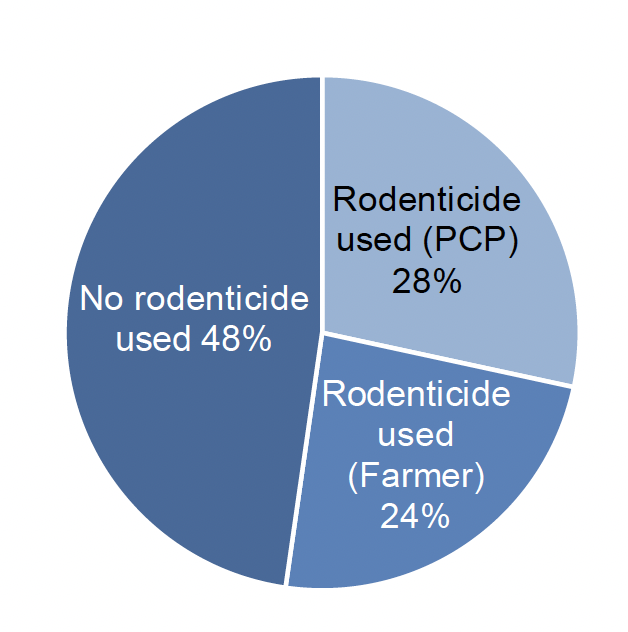
The estimated percentage of farms using rodenticides, and associated user type, in the previous two surveys (2018 and 2020) is presented in Figure 2. The proportion of arable farms using rodenticides in 2022 (52 per cent) was significantly lower (p-value 0.042) to that in 2020 (61 per cent) but there was no significant change between 2022, 2020 and 2018 when compared together (p-value 0.121).
In 2022, on farms where rodenticides were used, the proportion applied by PCPs (54 per cent) was significantly higher than in 2020 (43 per cent, (p-value 0.021)), but similar to 2018 (54 per cent). Recent surveys, since the introduction of the Rodenticide Stewardship Scheme, have shown a trend of an increasing proportion of farms using PCPs to apply rodenticides. It is possible the decline in use of PCPs in 2020 was influenced by COVID-19 and the subsequent lockdown, and that use of PCPs is now returning to pre-pandemic levels. Although pest management was classed as an essential sector during the pandemic some farmers may have preferred to conduct their own baiting rather than using external contractors, which may also have influenced the amount of rodenticides used in 2020.
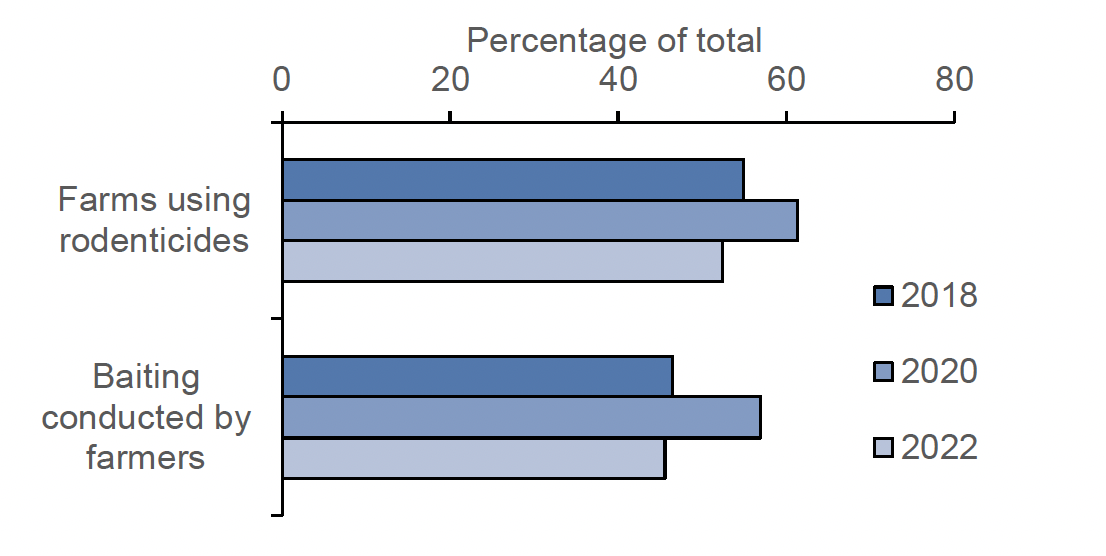
Note: The number of farms using rodenticide decreased significantly between 2020 and 2022. The proportion of baiting conducted by farmers also significantly decreased between 2020 and 2022 (p-value 0.021), returning to pre-pandemic levels.
Rodenticides encountered and their estimated occurrence
During this survey, product information was recorded for 95 per cent of all occurrences of rodenticide use. This is an increase from 2020, when products were specified in only 78 per cent of cases and from 2018, where 87 per cent of products were specified. For the remaining 5 per cent, whilst it was recorded that rodenticides had been applied, the product used was not specified. This was either a result of farmers not having adequate records of the exact product used or PCPs not responding to requests for product information. The level of unspecified rodenticides in 2020 was over 4 times higher than encountered in 2022 and was almost double that encountered in the 2018 survey (13 per cent). The spike in unspecified rodenticides in the previous survey may have been influenced by the higher proportion of farmers conducting baiting in 2020 due to the pandemic, as farmer responses are sometimes less detailed. The following sections only discuss the use of specified rodenticides.
Rodenticide occurrence is defined as the number of holdings on which a formulation (the combination of active substances formulated together in a product) is encountered. Multiple uses of the same formulation at the same holding are counted as a single occurrence (refer to Appendix 3 for further explanation of these definitions).
Seven active substances were recorded on arable farms in 2022; alphachloralose, brodifacoum, bromadiolone, coumatetralyl, difenacoum, difethialone and flocoumafen (Figure 3, Table 1). One active substance, alphachloralose, is a non-anticoagulant rodenticide licenced for use against mouse infestations only. The remaining six rodenticides encountered were anticoagulants, which prevent the synthesis of blood clotting factors and cause rodent death by haemorrhage. One of the active substances was a first generation anticoagulant rodenticide (FGAR; coumatetralyl). The other five anticoagulants were second generation anticoagulant rodenticides (SGARs) and these SGARs collectively accounted for 96 per cent of all occurrences of specified rodenticide use in 2022. This is lower than the previous two surveys, where rodenticide use was almost exclusively composed of SGARs (>98 and >99 per cent in 2018 and 2020 respectively). This difference between the proportion of SGAR use in 2022 and 2020 was strongly significant (p-value 0.004).
The most commonly encountered formulations were bromadiolone and difenacoum (41 and 37 per cent of occurrences respectively). Other formulations recorded were brodifacoum (16 per cent of occurrences), coumatetralyl (three per cent), difethialone, flocoumafen and alphachloralose (all one per cent) and bromadiolone/difenacoum (less than one per cent).
In past surveys, bromadiolone and difenacoum have been identified as the most commonly available rodenticides in terms of products available[3]. However, as the number of products containing brodifacoum has increased this situation has changed, and at the time of writing bromadiolone, difenacoum and brodifacoum containing products accounted for 21, 35 and 35 per cent respectively of all currently authorised rodenticide products. Bromadiolone and difenacoum accounted for all but one product authorised for use in open areas (the other being cholecalciferol)[4].
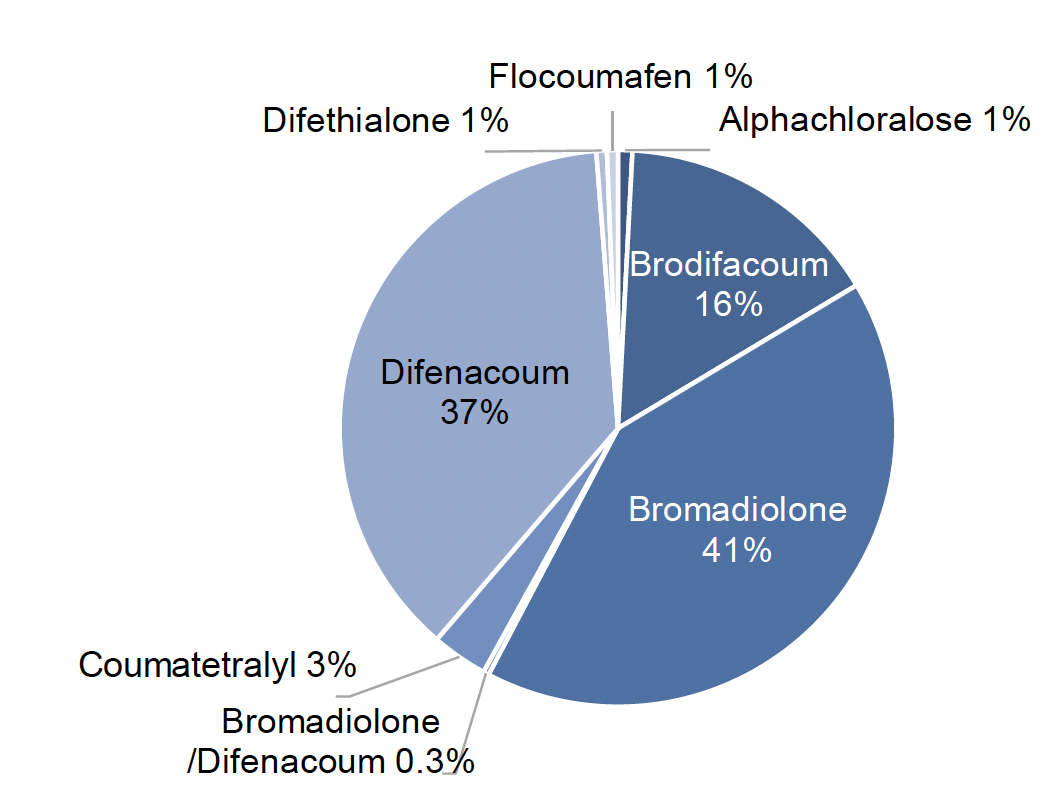
The combined use of bromadiolone and difenacoum fell to 79 per cent in 2022, after having changed little over previous surveys, this combination accounted for 90 and 92 per cent of rodenticide occurrences in 2018 and 2020 respectively. This change is largely due to an increase in use of brodifacoum and, to a lesser extent, coumatetralyl in 2022. The combined use of bromadiolone, difenacoum and brodifacoum accounted for 94 per cent of rodenticide occurrences in 2022. In 2022, the number of farms using bromadiolone was not significantly different compared to 2020 (p-value 0.144) but there was strong evidence of an overall decline across the years 2018, 2020 and 2022 (p-value <0.001). There was no evidence of a change in difenacoum use between 2020 and 2022 (p-value 0.142). However, considering 2018, 2020 and 2022 together, there was some evidence of a significant difference between the years, with more farms using difenacoum in 2020 (p-value 0.032).
There was a significant increase in use of brodifacoum between 2020 and 2022 (p-value 0.001) and strong evidence of an increase across the last three surveys (p<0.001) (Figure 4), brodifacoum use (16 per cent of farms) was more than double that recorded in 2020 and 2018 (7 and 6 per cent respectively), continuing a post-stewardship trend of increases. The mixed formulation bromadiolone/difenacoum was found at very low levels of use, accounting for less than one per cent of all specified occurrences in 2022, The relative proportions of these compounds vary in the longer-term dataset (1992 onwards), and it is not clear what the drivers for these variations are. It is possible that this may be a response to product efficacy in some areas; such as resistance to both difenacoum and bromadiolone which have both been reported in Scotland[5]. It may also represent a response to differences in the range of approved products available and their marketing strategies over time.
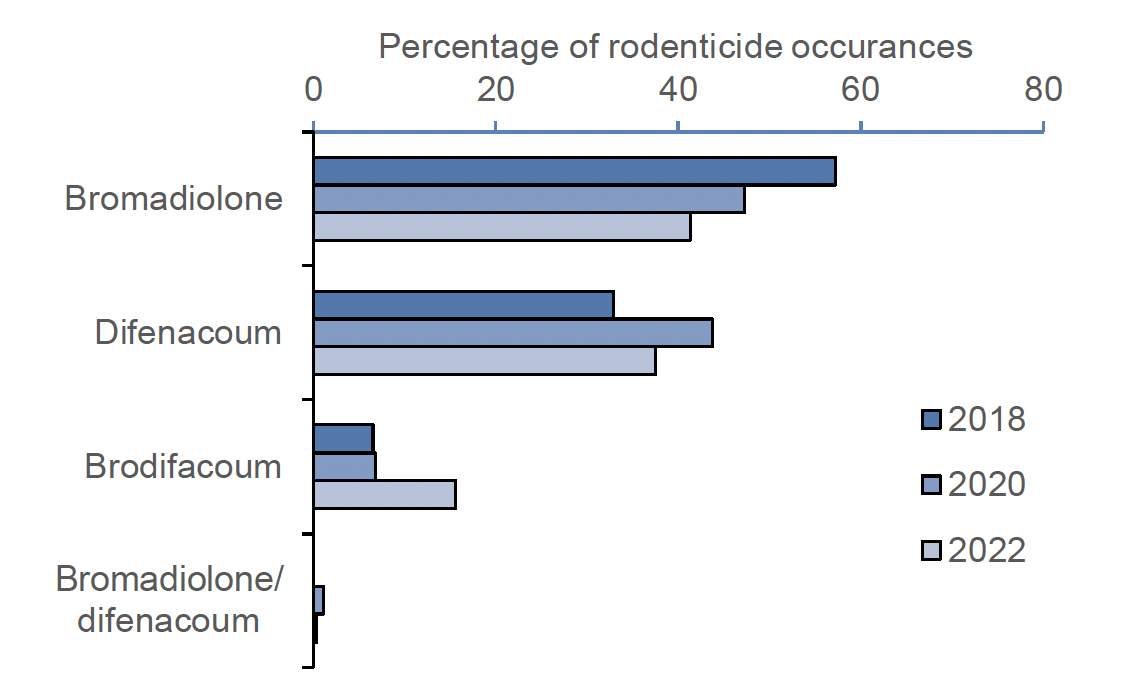
Note: there was no statistically significant change in the number of farms using bromadiolone (p-value 0.144) or difenacoum (p-value 0.142) between 2020 and 2022. In contrast, the number of farms using brodifacoum more than doubled between 2020 and 2022 (p-value 0.001).
Weight of rodenticides used
Just under 40 tonnes of rodenticidal products are estimated to have been used on Scottish arable farms in 2022 (Figure 5, Table 2), compared to around 62 tonnes in 2020. More than 99 per cent of the total weight used was SGAR products. Products containing bromadiolone were most frequently used (ca.22 tonnes), accounting for 54 per cent of total rodenticide use by weight. This was followed by difenacoum products (ca. 14 tonnes) accounting for 35 per cent of total use. The use of products containing Brodifacoum (ca. 4 tonnes) doubled compared to 2020 (ca. 2 tonnes). Alphachloralose, bromadiolone/difenacoum, coumatetralyl, difethialone and flocoumafen combined accounted for less than one tonne. Formulation weights (the weight of active substances present in the product not including baits) are also presented in Table 2. Anticoagulant rodenticide products contain very small amounts of active substance. The ca. 40 tonnes of rodenticide product used on arable farms in 2022 contained only ca. 2.8 kg of active substance, the remainder of the product weight is almost exclusively food bait used to attract rodents. This is similar to the estimated weight of active substance reported in 2020 (3.1 kg), despite an approximate 35 per cent decrease in the weight of rodenticide product. This may have been influenced by the amount of unspecified rodenticide recorded during 2020 but also that alphachloralose was recorded in 2022 but not in 2020. Alphachloralose products contain much higher levels of active substance (four per cent weight/weight (w/w)) compared with anticoagulants (ca. 0.005 per cent w/w).
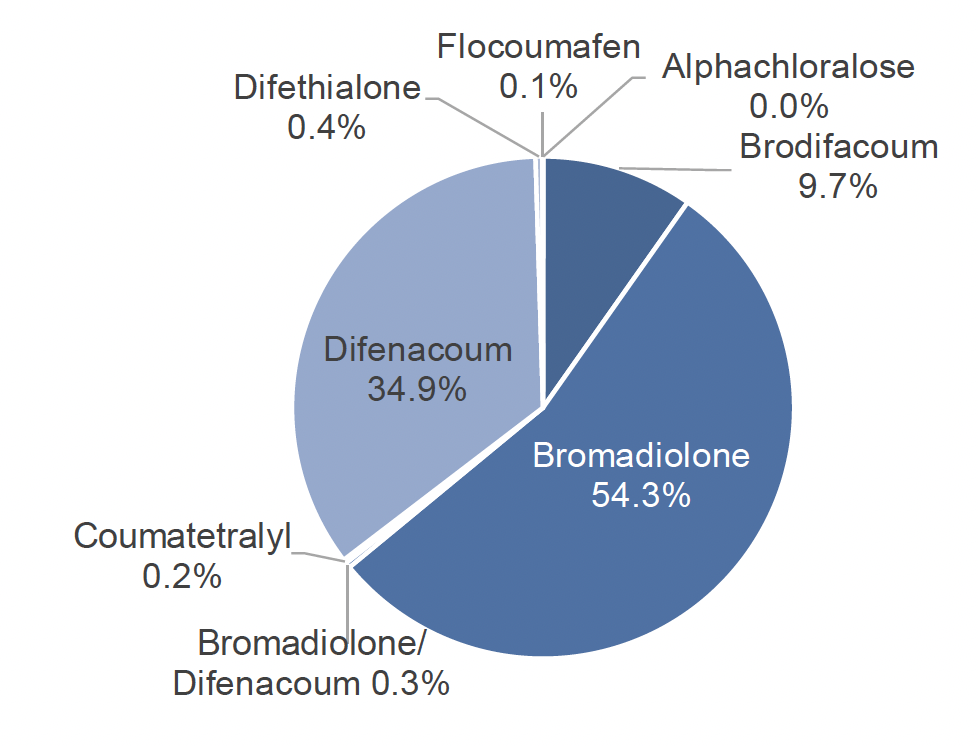
The estimated weights of the three main rodenticides recorded in the 2018, 2020 and 2022 arable crop surveys are presented in Figure 6. Overall rodenticide use in 2022 (ca. 40 tonnes) was 35 per cent lower than in 2020 (ca. 62 tonnes). However, the 2020 figure was itself an increase in use, the first for many years following a longer-term decline in rodenticide use in arable agriculture, and the reduction in 2022 may mark a return to that trend. Rodenticide use in 2022 was 18 per cent lower than in 2018 (ca. 49 tonnes) and 72 per cent lower than that reported in 2000 (ca. 144 tonnes)[6]. This has partly been driven by a decline in the proportion of farms on which baiting is conducted (76 and 52 per cent in 2000 and 2022 respectively), It may also have been influenced by the greater use of PCPs (35 and 54 percent of farms undertaking baiting in 2000 and 2022 respectively) and an increased awareness and application of best practice following the introduction of the rodenticide stewardship scheme from 2015.
At active substance level there was a 53 per cent decrease in the use of difenacoum in 2022 compared with 2020. However, the 2020 figure was considerably higher than the 2018 figure and difenacoum use in 2022 is still higher than in 2018 (by 26 per cent). The use of bromadiolone decreased by 27 per cent in 2022 compared with 2020 and by 39 per cent compared with 2018. In contrast, the use of brodifacoum in 2022 was more than double that recorded in both 2020 and 2018 (increasing by 165 per cent and 188 percent over these respectively). There is no consistent trend in use of the three main rodenticides over the last three surveys, although over a longer period the trend appears to be declining use of bromadiolone and difenacoum and an increase in brodifacoum. The reasons for the fluctuation in difenacoum in 2020 are unclear and it should be noted that rodent populations, and thus rodenticide use, fluctuate over time. The longer term decline in rodenticide use and increased use of PCPs, which were detected in both arable and grass and fodder crop systems, are likely to have been influenced by the Campaign for Responsible Rodenticide Usage (CRRU) guidance for best practice[7] and the 2015 launch of the UK industry led rodenticide stewardship scheme[8]. The increase in difenacoum use recorded in 2020 and the slightly lower use of PCPs may be a one-off exception to this trend influenced by the impact of the COVID-19 pandemic. It is not possible at this time to establish the impact of COVID-19 on farmer baiting operations and to indicate whether the 2020 data is an outlier, however, the 2022 data appears to indicate a possible return to the long-term trend. Further surveys may help to confirm this. The CRRU Code of Best Practice was revised and published in 2021 following a number of changes relating to the regulation and permitted practical uses of professional rodenticides and more recently CRRU announced further changes regarding the use of baits in open areas [9] (see rodenticide approval and stewardship section for further details). These changes could influence future rodenticide use.
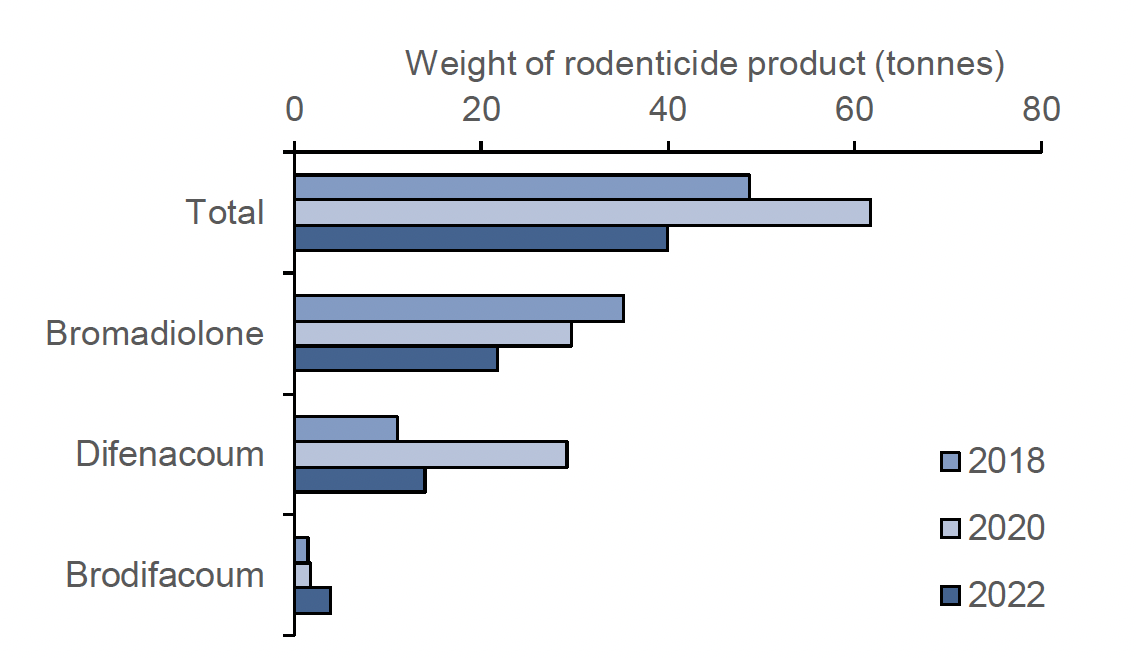
Note mixed bromadiolone/difenacoum formulated products are included in total.
Seasonal use of rodenticides
The season in which rodenticides were used was specified for over 99 per cent of the rodenticides encountered in this survey. Forty-six per cent of use was reported to occur throughout the year. This included farms practising permanent baiting and those conducting multiple separate baiting operations. This is similar to the level reported in 2020 (45 per cent used all year round) but lower than 2018 in which 61 per cent of rodenticides were reported to be used throughout the year. However, similar levels of year-round baiting for anticoagulant rodenticides have been reported previously, with 46 per cent in 2016.
When the weight used, including year-round use, is separated into constituent seasons, the greatest use was in winter (30 per cent) and autumn (29 per cent), slightly lower use in summer (25 per cent) and lowest use in spring (16 per cent) (Figure 7). Summer use was lower in previous surveys (ranging from 13 per cent to 18 percent from 2014 to 2020).
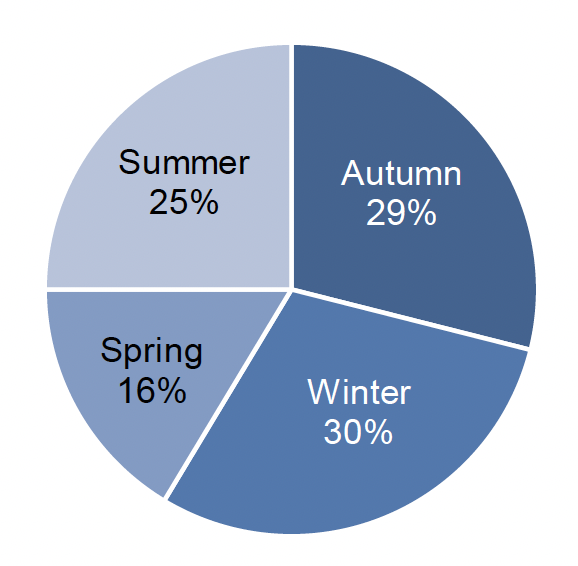
Rodenticide bait type and target
As with the previous survey, baits formulated with grain were the most commonly encountered in this survey, accounting for 93 per cent of use by weight (Figure 8). These baits were primarily loose grain and place packs containing grain, but also included a small amount of grain-based paste (<1 per cent of total grain baits).
The other types of rodenticide products encountered included wax-based baits, which accounted for 5 per cent of use. Seventy-four per cent of wax baits were solid wax baits and 26 per cent were soft waxes. Pasta based bait contributed two per cent of total use, foam rodenticides and other paste baits (for which the type of bait was not specified) were both estimated to account for less than one per cent. No gel rodenticides were encountered in 2022.
Grain baits also accounted for the majority of rodenticides used in the previous two arable surveys in 2020 (82 per cent) and 2018 (90 per cent).
Survey respondents were asked to state the target of their rodenticide baiting regimes (Figure 9) and this information was supplied for all estimated use by weight. The most common target was a combination of rats and mice (57 per cent), followed by rats (40 per cent). Only three per cent of rodenticide use was targeted at mice alone. In the previous surveys in 2020 and 2018 the principal target was also a combination of rats and mice (51 per cent and 52 per cent respectively).
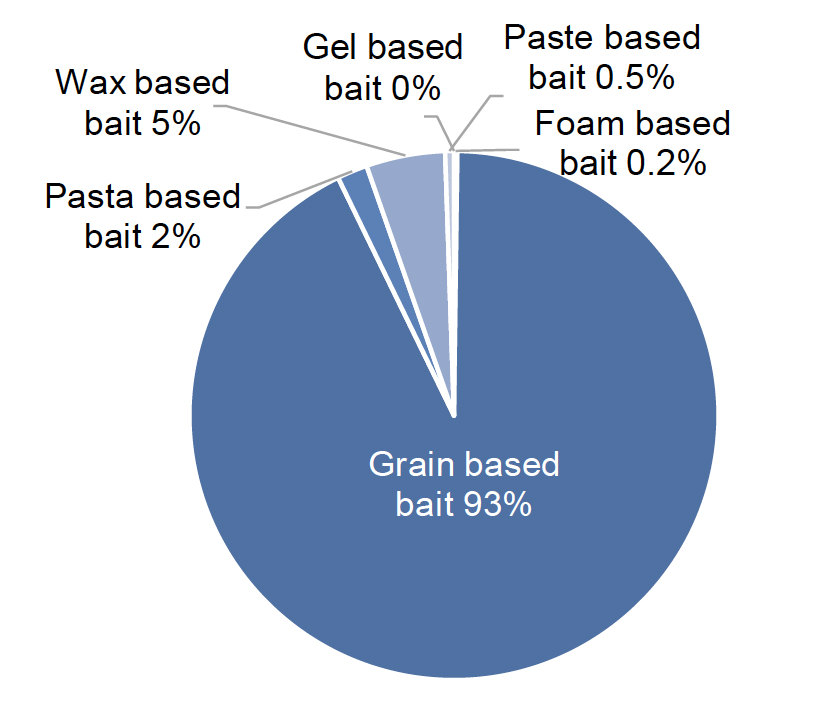
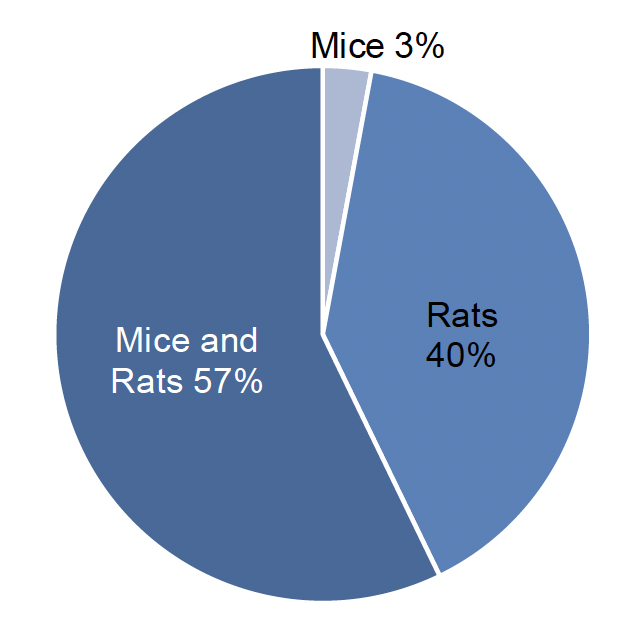
Contact
Email: wildlifeunit@sasa.gov.scot
There is a problem
Thanks for your feedback